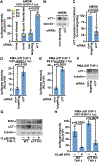xCT/SLC7A11 antiporter function inhibits HIV-1 infection
- PMID: 33631414
- PMCID: PMC7925438
- DOI: 10.1016/j.virol.2021.01.008
xCT/SLC7A11 antiporter function inhibits HIV-1 infection
Abstract
Human macrophages are protected by intrinsic antiviral defenses that provide moderate protection against HIV-1 infection. Macrophages that do become infected can serve as long-lived reservoirs, to disseminate HIV-1 to CD4+ T cells. Infection of macrophages with HIV-1 and HIV-2 is inhibited by constitutive mobilization of antioxidant response master transcription regulator Nrf2. The downstream mediator of this restriction was not identified. Among the tens of genes controlled directly by Nrf2 in macrophages, we found that xCT/SLC7A11, a 12-transmembrane, cystine-glutamate antiporter promotes antiretroviral activity. We show here that depletion of xCT mRNA increases HIV-1 infection. Reconstitution of xCT knock out cells with wild-type xCT but not a transport-deficient mutant restores anti-HIV-1 activity. Pharmacological inhibitors of xCT amino acid transport also increase infection. The block is independent of known restriction factors and acts against HIV-1 and HIV-2. Like the block triggered through Nrf2, xCT function impedes infection immediately before 2-LTR circle formation.
Keywords: 2-LTR circle; Erastin; HIV-1; HIV-2; Late reverse transcription; Restriction; SLC7A11; Sulfasalazine; Sulforaphane; xCT.
Copyright © 2021 Elsevier Inc. All rights reserved.
Figures






Similar articles
-
The glutamate/cystine antiporter SLC7A11/xCT enhances cancer cell dependency on glucose by exporting glutamate.J Biol Chem. 2017 Aug 25;292(34):14240-14249. doi: 10.1074/jbc.M117.798405. Epub 2017 Jun 19. J Biol Chem. 2017. PMID: 28630042 Free PMC article.
-
The glutamate/cystine xCT antiporter antagonizes glutamine metabolism and reduces nutrient flexibility.Nat Commun. 2017 Apr 21;8:15074. doi: 10.1038/ncomms15074. Nat Commun. 2017. PMID: 28429737 Free PMC article.
-
Analysis of the effects of polyunsaturated fatty acids on transporter expressions using a PCR array: Induction of xCT/SLC7A11 in human placental BeWo cells.Placenta. 2019 Jan;75:34-41. doi: 10.1016/j.placenta.2018.11.010. Epub 2018 Nov 27. Placenta. 2019. PMID: 30712664
-
Cystine-glutamate antiporter xCT as a therapeutic target for cancer.Cell Biochem Funct. 2021 Mar;39(2):174-179. doi: 10.1002/cbf.3581. Epub 2020 Aug 4. Cell Biochem Funct. 2021. PMID: 32749001 Review.
-
Cystine transporter SLC7A11/xCT in cancer: ferroptosis, nutrient dependency, and cancer therapy.Protein Cell. 2021 Aug;12(8):599-620. doi: 10.1007/s13238-020-00789-5. Epub 2020 Oct 1. Protein Cell. 2021. PMID: 33000412 Free PMC article. Review.
Cited by
-
Sulforaphane Reduces SAMHD1 Phosphorylation To Protect Macrophages from HIV-1 Infection.J Virol. 2022 Dec 14;96(23):e0118722. doi: 10.1128/jvi.01187-22. Epub 2022 Nov 15. J Virol. 2022. PMID: 36377871 Free PMC article.
-
Transcriptome profiles of latently- and reactivated HIV-1 infected primary CD4+ T cells: A pooled data-analysis.Front Immunol. 2022 Aug 26;13:915805. doi: 10.3389/fimmu.2022.915805. eCollection 2022. Front Immunol. 2022. PMID: 36090997 Free PMC article.
-
Characterization of substrates and inhibitors of the human heterodimeric transporter 4F2hc-LAT1 using purified protein and the scintillation proximity radioligand binding assay.Front Physiol. 2023 Feb 21;14:1148055. doi: 10.3389/fphys.2023.1148055. eCollection 2023. Front Physiol. 2023. PMID: 36895635 Free PMC article.
-
Proteomic characterization of four subtypes of M2 macrophages derived from human THP-1 cells.J Zhejiang Univ Sci B. 2022 May 15;23(5):407-422. doi: 10.1631/jzus.B2100930. J Zhejiang Univ Sci B. 2022. PMID: 35557041 Free PMC article.
-
Advancing the preclinical study of comorbid neuroHIV and substance use disorders: Current perspectives and future directions.Brain Behav Immun. 2023 Oct;113:453-475. doi: 10.1016/j.bbi.2023.07.021. Epub 2023 Aug 9. Brain Behav Immun. 2023. PMID: 37567486 Free PMC article. Review.
References
Publication types
MeSH terms
Substances
Grants and funding
LinkOut - more resources
Full Text Sources
Other Literature Sources
Medical
Research Materials

